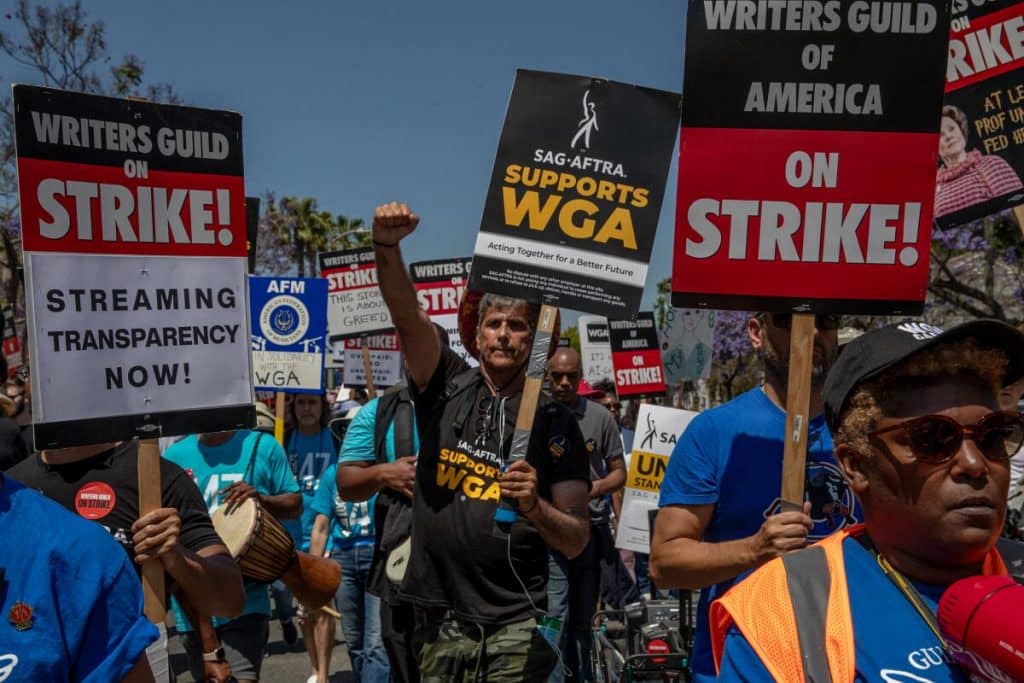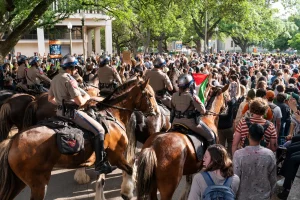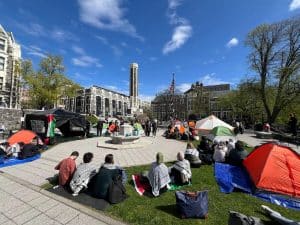As 2023 draws to a close, one of the biggest stories of the year was the “hot labor summer” and the overall rise of labor activity. The most significant of these strikes was the UAW strike, which began in mid-September and lasted until mid-October.
The Hollywood strikes of the Writers Guild of America (WGA) and the Screen Actors Guild-American Federation of Television and Radio Artists (SAG-AFTRA) probably generated fewer high-profile headlines. But they deserve some special attention for a few reasons. The strikes ground a highly lucrative industry to a halt, and they cost California and other production-heavy states at least $6 billion in lost wages and business impacts. But they also contained the seeds of some of the most important lessons for the U.S. labor movement.
As we look back on the year in labor struggle, it is clear that the Hollywood strikes represented important shifts in worker consciousness and helped lay some of the groundwork to shift the labor movement toward more militancy.
Rumblings of Major Shifts in Class Consciousness
First of all, two unions went on strike at the same time and intentionally linked their struggles — including picketing together. This helped show the potential power of a true joint strike. The Hollywood strikes, then, are bucking a major and harmful trend in the labor movement: that of isolated strikes.
Joint strikes have become rare over the last few decades in the United States. And there’s a good reason: bosses hate them. In the 1940s and 1950s, unions synced up their contract expirations, making it easier for them to organize together against bosses, creating more leverage and pressure. Kim Moody recounts how, in 1945–46, just after the war, 4.6 million workers went on strike in a massive wave — oil workers, coal miners, lumber workers, autoworkers, meatpackers, and more. There were many reasons for the strike wave, but it was helped along by shorter contracts ending at about the same times. In the following decades, longer, non-synced contracts became the norm. Compare that to the 1930s, when contracts were often just a year or two long. This change helped break down the solidarity between unions.
Because these two powerful Hollywood unions both had contracts expiring at the same, they could strike simultaneously and explicitly link their struggles — in what became Hollywood’s first “joint strike” since 1960. In doing so, they revealed the power that unions have when they stand together, and showed a deepening “class consciousness,” a sense among the union members that, to put it simply, we’re all in this together.
You might be interested in: The UAW Won Big: What Does It Mean for the U.S. Labor Movement?
But union solidarity reached past the entertainment industry. The Hollywood strikes stood in solidarity with other sectors on strike — including the UAW, whose pickets were joined by SAG-AFTRA members. And the Hollywood strikes were supported by the Hollywood Teamsters, who refused to cross picket lines. In other words, there was a rise of a cross-industry sense of solidarity in which workers saw the links between them across very different kinds of jobs.
This cross-industry solidarity pushes at the boundaries of labor law, which limits when and how workers can legally strike. In 1947, Democrats and Republicans passed the Taft-Hartley Act, which tried to rein in union and worker power. One of its provisions forbids workers in one industry from participating in another’s strike — what the law calls a “secondary” and “solidarity” strike. It’s no secret why such strikes are forbidden: they can disrupt not just one industry but large swathes of the U.S. capitalist economy. When UAW, SAG-AFTRA, WGA, and the Teamsters linked up in striking, they challenged that law, which tries to isolate struggles from each other. If the labor movement is going to build its power, it’ll have to continue challenging labor law and be unafraid to break labor law. That’s because, as Joe Burns points out in Class Struggle Unionism, labor law exists to hamstring the labor movement.
The Hollywood strikes, however, were not truly joint actions. WGA and SAG-AFTRA were on strike at the same time, against the same employer, but they had different contracts, which were negotiated separately. This provided an opening for the bosses of Hollywood to break the unity of the strikes by getting WGA back to work earlier than SAG-AFTRA. WGA ended up getting a significantly better deal than SAG-AFTRA, and this reflected how the loss of unity affected the struggle.
WGA could bargain with the full power of the joint strike behind them, but once they were sent back to work — a decision made with the consent of the WGA union bureaucracy, who agreed to go back to work before the actors — this left SAG-AFTRA more isolated. Getting WGA back to work earlier also helped restart Hollywood production, since writers are the first step in the production process; this pressured the actors to make concessions in their struggle, as the industry began to restart around them. Another important factor that weakened the unity of the strike was the Directors Guild of America’s (DGA) decision to take a weak agreement rather than join the strike.
Still, the strikes didn’t just show an important shift in consciousness among the workers themselves; it also showed shifting consciousness in the masses as well. We catch a glimpse of this shifting class consciousness from just how popular the Hollywood strikes were. Despite being easy to smear as “privileged Hollywood elites fighting for more money” — which would have been a disingenuous characterization of the actual struggle — the strikes enjoyed broad support from the public with 50 percent saying they support the strike with only 9 percent saying they oppose it, according to a poll taken in September. This is in keeping with the broad support for labor struggles also shown in the mass public support for the UAW strike. What this reveals is that, in keeping with data we’ve been seeing for a while, the masses are also shifting their consciousness, not just among unions but among the broader public, and beginning to support workers against the bosses.
Another notable aspect of the Hollywood strikes is that they were among the first major strikes to take up the issue of technology and how the bosses use it against workers. While other elements — such as residuals — were also key parts of why the unions went on strike, in many ways the WGA and SAG-AFTRA strikes became known for their struggle against the use of AI. This new technology, it is feared, will be used to put workers out of work and help the studios increase profits by cutting down on the costs of paying real writers and actors. By taking aim at the use of AI and its potential ramifications, the Hollywood strikes showed workers using their labor power to gain leverage over new technology.
This was also echoed in the UAW strike, which was deeply connected to the growth of electric vehicles (EVs) and how the shift in production toward making more EVs could be used by the bosses to break the union and weaken worker power. The UAW strike, like the Hollywood strikes, was an attempt by workers to gain leverage over this new technology and ensure that it isn’t used against workers. While the outcome of both the UAW strike and the Hollywood strikes — particularly the SAG-AFTRA deal — didn’t go far enough in gaining that leverage, it is undeniable that workers are beginning to realize that technology, in the hands of the bosses, will be used against them and that they must use their fighting power to gain leverage over how it is used.
To some extent, this is an instance of workers seeking to control production, if in a limited way. They are rejecting the idea that bosses should decide how technology is used in production. This is a latent, but deeply progressive, shift in the labor movement, one that points toward workers fighting more and more to control how production operates. This is key to ensuring that workers eventually take the means of production up into their own hands.
In addition, the Hollywood strikes were also notable for the ways that they took up issues other than “bread and butter” demands over pay and conditions. The strikes explicitly took up questions of special oppression and had themed pickets around issues of abortion, racism, and queer struggle. As we wrote in July:
From “Pride Pickets,” to speakers at rallies taking up the question of abortion rights, to members connecting the issues of structural racism to the strike, the strikes have shown that the solidarity shown in the strike goes deeper than just between the two sister unions. Indeed, what these strikes are drawing out is that the fight against exploitation is profoundly tied to the fight against oppression. In the case of the current strike, union members and activists are pointing out that — because TV and film production happens all around the country — the laws against abortion have direct impacts on these workers’ lives. These links are necessary in order to win big in this strike. Connecting struggles across the working class is both good in itself — as it helps show the power that labor can bring to struggles against oppression — and also tactically necessary for the unions. The strength of the bosses and their commitment to ensuring that they are able to extract as much surplus value as possible out of their workers mean that, in order to actually stand strong against them, the unions must connect to wider and more militant struggles in order to have the forces possible to win. By showing how this struggle is connected to other on-going struggles, the unions are able to show the unity between struggles and bring more people into the fight.
Where to from Here?
The Hollywood strikes showed the power and importance of worker solidarity. As 2024 opens, workers will need to build on these struggles and take further steps to establish unity. This will build up the power of each individual struggle and strengthen the union movement more broadly.
Already, the ground is being laid for more joint labor actions in the future. UAW president Shawn Fain is calling for other unions to sync their contract expirations with the UAW’s, in order to set up a potential general strike in 2028. We cannot wait till 2028, however. Syncing our struggles — which will increasingly force unions to face down repressive labor laws — has to begin now, and we can build on not only what we saw in Hollywood in 2023 but also what we are seeing in the labor movement for Palestine, where many unions from across different industries are joining the struggle for a ceasefire. This must be built on in order to strengthen and deepen the power of the labor movement.
You might be interested in: Our Unions Need to Join the Fight for Palestinian Liberation — Right Now
The roadmap of 2024 is more challenging for labor than 2023 — purely because there are fewer big contract expirations happening this year. There are important exceptions to this, however, including in Hollywood. Hollywood technical workers — organized with IATSE — have a contract expiring in 2024, which gives workers the chance to fight back after the last contract was imposed on them undemocratically by their bureaucracy in 2021 in order to avoid a strike. IATSE workers can take inspiration from their sister unions and call on them to stand with them as they begin their own struggle.
The railroad unions also have a contract expiring in 2024. The last railroad struggle ended with betrayal as the Democratic Party, including members of the progressive wing, forced them back to work, even after the membership had voted down the proposed contract. That forced contract expires in 2024 and will provide an important opportunity for labor to fight back against the Biden regime, which, despite calling itself “pro-labor” and performatively supporting the UAW strike, is solidly on the side of the bosses.
Outside of contract expirations, there is also the fight for new contracts as more and more new unions — from Starbucks to higher education — are formed. The shifts in class consciousness were clear in 2023. In 2024 we will need to deepen these shifts and push them further in order to make a strong, militant, and political labor movement.











